Excerpt from the book “Pairings of spanish wines with exotic cuisines”.
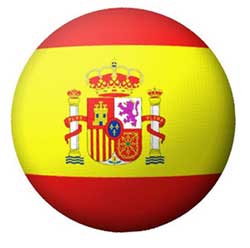 Pueden ver la versión española pinchando en Recetas asiáticas
Pueden ver la versión española pinchando en Recetas asiáticas
The ingredients are calculated for 4 people
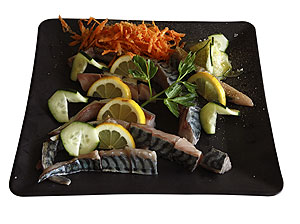 Assorted sashimi
Assorted sashimi
100 grs. salmon
100 grs. red tuna
1 mackerel
1 medium-sized squid
4 prawns
1 Daikon turnip
Wasabi and soya sauce
This dish is usually confused with sushi in Europe, but they are totally different. Sashimi consists of raw fish, while sushi is a preparation of rice which can have some slice of raw fish or not.
Sashimi is not a popular dish but the luxury food par excellence in Japanese cuisine.
A good sashimi cutter is considered an artist, something usual in this country, where there the difference between an artist and a craftsman is not as definite as in the Western world.
There are three key aspects that must be taken into account to achieve brilliant results in this preparation: the selection and quality of the ingredients, the beauty of the dish and the variety and cleanness of the cuts. I have described a number of them in my web so I will not repeat it; I will only give you a couple of general ideas.
Only the tube of the squid must be used, clean and without tissues, both inner and outer. It must be split and cut into strips.
Take off the transparent skin of the mackerel, which is leathery. Use the upper sides, cut into slices or small dices. Chop the rest to make a tartar as is described in its recipe.
Tuna and salmon must be cut into blocks and then filleted into pieces to fit in the mouth. Use the cut-offs for the tartar.
Peel the prawns and take off the cordon, since it may contain sand. Use the bodies, split in two halves. They must be very fresh; do not use imported prawns, which may contain bacteria.
Cutting the turnip is difficult; you may simply grate it and put it in icy water for some minutes.
Soya sauce and wasabi must be served separately and the seafood must be arranged according to species and trying to get an attractive mosaic.
Remember that sashimi has no rice in it, so each diner must have a bowl with Gohan. You may also garnish the dish with some pieces of Nori Maki-Sushi, Nigiri Sushi or any other sushi.
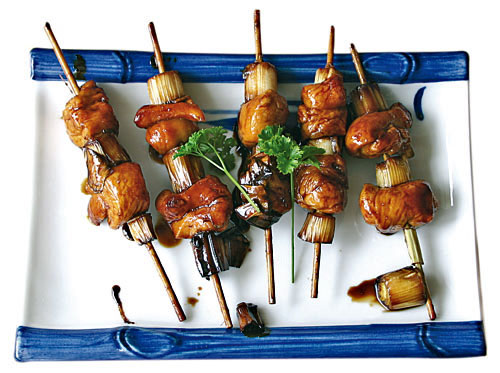 Chicken Yakitori
Chicken Yakitori
2 chicken breasts
3 leeks
Teriyaki sauce
12 bamboo skewers
This is a very popular way of eating in Japan.
There are even restaurants where only yakitori is served, prepared in a thousand ways. They are called izakaya, which means “sake shop”, and people often go there after work to have some skewers with sake before going home for supper.
A very similar custom as Spanish pinchos, mainly because they do not usually drink sake but beer.
We are going to prepare the most popular and usual yakitori. The most time-consuming part is to make the skewers, so we can prepare them in advance.
Wash the leeks and cut them into bite-sized pieces. Chop the chicken in a similar way.
Other vegetables and other parts of the chicken may be used, but I like them this way. The order can also be varied at taste. I usually start with a piece of leek, than chicken, leek, chicken and leek again to finish. Coat with Teriyaki sauce and marinate until the moment of eating.
They can be cooked on a grill or on a griddle. The heat must not be very strong. Turn them over when they start getting caramelized. More sauce can be added during cooking until they are completely lacquered.
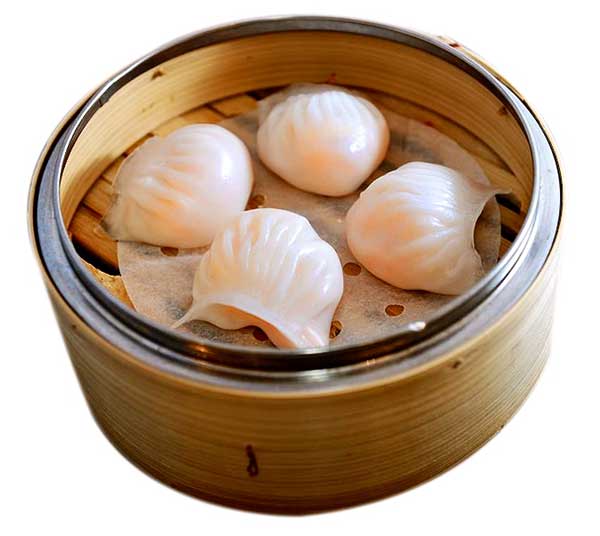 Dim sum
Dim sum
12 wonton wafers
4 large raw shrimps
1/2 chicken breast
1/2 onion
2 garlic cloves
1 fresh red chilli pepper
Sunflower oil
The word "dim sum", as most Chinese words, has got many meanings, but the most appropriate one for this dish is "bites", because that is what they are, bites of a thousand things that are sold in the streets and consumed by the millions of citizens in Canton, mainly in Hong Kong, since breakfast until they go back home at night.
Nowadays they are also served in elegant restaurants specializing in those preparations, such as the Dim sum Club.
They are small pasties that are usually steamed, sometimes fried, and can be stuffed with anything, even the most incredible combinations.
I have chosen chicken and shrimps because it is the most traditional flavour, but there are some really amazing fillings, such as duck and mushrooms, a delicacy.
To prepare the filling, peel the shrimps and take off the black cord, which can have sand in it. Cut them into very small pieces.
Cut the chicken breast, red chilli pepper, onion and garlic very thinly.
Put some soya oil in a frying pan, pour all the ingredients in it and sauté for fifteen or twenty seconds, just to mix the tastes.
Let stand for a while, until you can manipulate them with no difficulty. This will enhance the tastes. Try and add salt and pepper to the taste.
Lay the wafers out and put a spoonful of the filling on each one. Wet the rim so that it sticks well. Fold them and press along the rim with your fingers until each package is totally closed.
Put them in wicker steamers and these in turn in a pot the same size, on top of one another, so that the steam goes up and cooks all the dim sum at the same time. It is easy to know when they are ready, you only have to try a little bit of the dough and check if it tastes raw, since the filling needs very little heat.
Serve as they are, with their own bamboo covers if possible to keep them warm and soya and sweet-and-sour sauce in small bowls to dip them to taste.
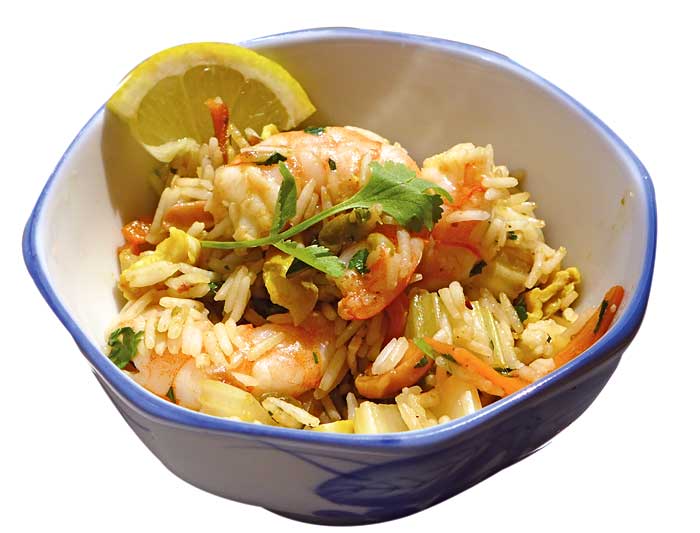 Fried rice with shrimps
Fried rice with shrimps
1 glass Basmati rice
3 sticks green celery
12 large fresh shrimps
3 garlic cloves
½ red onion
½ green pepper
3 spoonfuls fried cashew
3 spoonfuls peas
3 eggs
2 carrots
1 lemon
Fresh coriander and spearmint
Rice can be cooked in many ways in Asia. One of them is what is known as “fried rice”, a simple cooking technique that is included in many recipes, as the rice is boiled in water and then mixed with the ingredients of the dish.
Start by boiling the rice, which must be long-grain but not parboiled. We have chosen Basmati, an Indian variety that is easy to find in our market. Calculate double volume of water than rice, add salt and bring it to boil. Ten minutes should be enough, but make sure that the water has been absorbed and there are small holes on the surface. Set aside.
Now we have to cook the omelette. Beat the eggs with a dash of water and fresh or dry spearmint. Pour it in a low frying pan, crépe-style, and wait until it sets. When there are no liquid parts left, roll it –in the pan or on a table- and set aside.
To make the stir-fry, prepare all the ingredients at the same time. We are going to sauté them on a strong heat so that they are crispy and almost raw.
Chop the onion, pepper, carrot, celery and garlic. Put them in a wok with a little oil. Sauté them over a strong heat, add the cashew and the peas and stir well.
Chop the omelette roll and add it to the stir-fry. Add the boiled rice and the raw shrimps. Sauté strongly and the dish is ready.
It is advisable to sprinkle some chopped fresh coriander on it and put some lemon slices aside so that each diner can add it to taste. A jug with soya sauce must also be on the table.
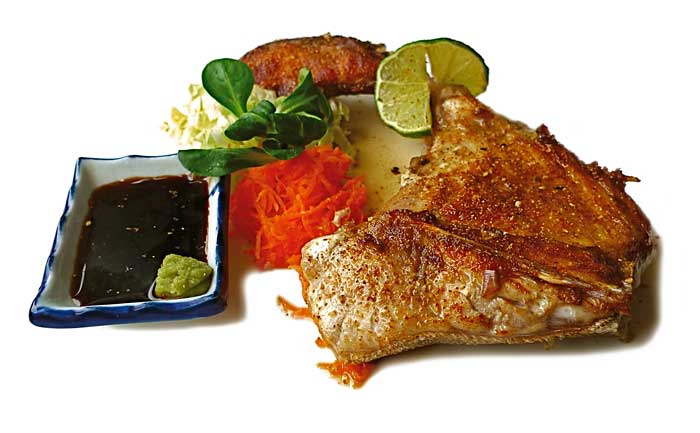 Hamachi Kama
Hamachi Kama
4 collars of grouper
Japanese spices
Chinese cabbage
2 carrots
Soya sauce
Lemon
Wasabi
Extra virgin olive oil
This dish is hard to find in Japanese restaurants in Europe, because land prices make them have tiny kitchens and use pre-cooked food. As a consequence, cooks cannot use the collars of fish, which is usually bought in fillets.
In Japan it is usually prepared with the collars of a farming perch called “yellowtail”, but you may use any fish. It will certainly be tastier with sea fish.
The collar is the part of the fish that is close to the head, through which the gills can be seen. In Spanish it is known by a variety of names: collar, ijada, parpatana, pestaña, oreja… It is a large bone full of smaller bones and cartilages that make it difficult to eat except for gourmets who know about fish, but it is a delicacy. This part of the fish offers such a variety of tastes that it can be cooked Osaka-style, which is simply grilled without anything else, and diners may add lemon or soya sauce to it at the table.
I do not have a fire grill so I had to grill it on a griddle, and I had to cook it for longer than usual because I used a big collar –grouper, not yellowtail. I seasoned it with sansho no kona and shichimitogarashi, and dipped some small pieces in soya sauce with wasabi.
Before cooking the dish you should prepare some salads as side dishes, because there must always be some refreshing element.
Daikon turnip is the usual Japanese choice, but I do not fancy it, so I made a salad with Chinese cabbage and carrot, seasoned with lemon and extra virgin olive oil, although this kind of oil is not orthodox in Japan.
 Japanese salmon tartar
Japanese salmon tartar
1 kg. fresh salmon
1 leek
½ ginger bulb
Soya sauce
Wasabi
Actual tartars are not usually prepared in Japan. Their closest dish could be Aji no sugata-Zukuri, which is a kind of sashimi, chopped fish dipped in soya sauce, but when you prepare Hira-Zukuri, Sogi-Zukuri, or Usu-Zukuri , the noblest cuts, there are always trimmings that can be used as Kaku-Zukuri or even smaller, which would be a tartar.
In this case we have chosen salmon, one of the most valued luxury fish in this country, seasoning it the same way as we would with a sashimi.
Even a traditional sashimi looks good with a small pile of this tartar, made from the trimmings.
To start with, then, chop very thinly the fish, clean and boneless. It is a bit bigger in the picture, to show that it has not been ground.
Put a teaspoon wasabi and a dash of soya sauce in a bowl. Add some very thin slices of raw leek (from the part where green and white mix), some trips of lemon peel (just the yellow part) and grated fresh ginger as yakumi (flavouring).
Beat well, add salmon and stir slowly using chopsticks or a wooden spoon.
It can be served by itself or as a part of an assorted
sashimi.
.jpg) Lacquered prawns
Lacquered prawns
20 raw prawns
1 ginger bulb
1 leek
5 garlic cloves
1 spoonful lard
1 spoonful honey
1 glass fish stock (fumet)
1 small glass sake
1 small glass mirin
1 small glass soya sauce
1 spoonful bitter orange marmalade
This is a speciality from Shangdong, one of the seven great Chinese cuisines, whose most remarkable feature is the use of seafood from Bohai, that wide gulf fed by the Yellow Sea where people have lived from fishery from ancient times. Nowadays it is the area with the greatest maritime traffic in the world and its biggest income comes from oil revenues.
It is a delicious dish that has been abused by wedding caterers, so if you have tried it before, forget that bad experience as it is a delicacy.
Peel the body of the prawns, keeping the head and the tail. In a wok, put the lard and honey together with leek, ginger and garlic thinly chopped. Cook it until it starts getting dry. Add the fish stock, sake and mirin (or vinegar with sugar), a dash of soya sauce and a spoonful of bitter orange marmalade. The marmalade substitutes Wei Jing sauce, which is difficult to get in Spain and even more difficult to cook.
When it starts getting a dense texture, pass it through a Chinese strainer and put it in a frying pan. Heat well and, when the diners are already sitting at the table, add the prawns, cook quickly on both sides and remove. They must be juicy, almost raw inside, keeping the seafood taste, enhanced and framed by the sweet-and-sour sauce.
As a side dish, prepare some vegetables cut into small sticks and slightly sautéed in a wok.
.jpg) Orange duck wings
Orange duck wings
12 confited duck wings
1 large onion
2 oranges
5 garlic cloves
1 ginger bulb
2 spoonfuls brown cane sugar
Extra virgin olive oil, salt and pepper
The boring part of this recipe is to prepare and caramelize the wings, but they can be purchased canned and they are high quality.
Start with the sauce. Peel and slice the onions. They used to be fried in duck fat, but it will be much healthier to use extra virgin olive oil. Cook on a low heat.
Meanwhile, peel the ginger, slice it and cut the slices into sticks. Its taste will be hardly noticed once cooked, because the acid in the orange will neutralize the itchy taste, but it is enjoyable to find small bits in the sauce.
Chop the garlic. When the onion starts to brown, add the garlic and the ginger, and sprinkle the brown sugar on it. Grate the peel of one orange and add it to the stir-fry.
Squeeze the oranges and add the juice to the stir-fry when it gets caramel-colour. The peels can also be added, or half an orange slice for garnish. Cook until it gets a texture like syrup and set aside.
Fry the wings in their own fat (they are prepared that way in the can). When the skin is crispy, transfer them to the serving dish and cover with the sauce.
It is advisable to garnish the dish with sliced raw leek, known as Yakumi, which will enhance the tastes by contrast.
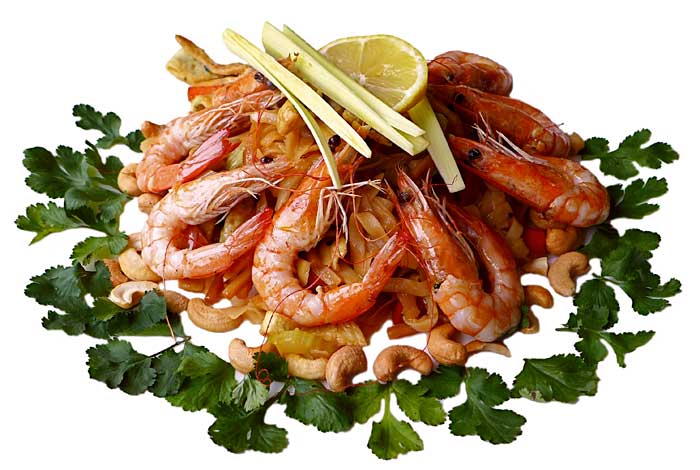 Pad Thai
Pad Thai
12 raw prawns
1 packet rice noodles
3 eggs
1 ginger bulb
1 can soya or bamboo stalks
2 carrots
1 leek
3 stalks green celery
1 packet dry tofu
2 spoonfuls tamarind or passion fruit pulp
1 spoonful oyster or fish sauce
Soya sauce or Tamari
1 small bag cashews or fried peanuts
1 bunch fresh coriander
Pad Thai is the national dish in Thailand, the same as our paella here, so there are a thousand variations according to the ingredients available in each area. This Pad Thai respects traditional tastes, but it has been cooked with ingredients that are easy to find in any European market. It should be cooked in a wok.
Cut the vegetables into small sticks (ginger must be peeled, sliced and then cut into sticks), dice the tofu and drain the stalks (or wash them if they are fresh).
Put some neutral (soya) oil in the wok and sauté these ingredients for a minute on a strong heat. Set aside.
For the omelette, beat the eggs with a dash of water and some fresh coriander leaves thinly chopped. Put some oil in a low frying pan, crêpe-style, and pour the beaten egg into it. When it sets, remove from heat, roll the omelette, slice it and add to the wok.
Fill a saucepan with salted water and take it to the boil. Add the noodles and let them boil for a few seconds –you can easily see when they get soft. Drain and add to the wok with the rest of ingredients. Add the tamarind pulp, a spoonful of oyster sauce and a dash of soya sauce. Cook a bit a set aside.
Peel the prawns (they look better if the heads and tails are kept) and sauté them in a frying pan for a few seconds – they must be juicy.
As you can see in the picture, I have set my own dish presentation, but in Thailand it is usually served all mixed up in the wok.
.jpg) Peking lacquered duck
Peking lacquered duck
1 free-range duck
Molasses or rosemary honey
12 wafers “ad hoc”
1 leek
1 bunch chive
Hoisin sauce
As evidenced in many written documents, at the beginning of the 13th century, when the Mongols conquered China and established the Yuan dynasty, they already used to eat this delicacy in their palaces in Xanadu, but it was the Ming dynasty who loved this preparation so much that it became known worldwide by the name of their capital, Peking.
This dish is really delicious, but it is impossible to cook at home because it requires a large wood-fired oven where the ducks can be hung to get slowly roasted at the same time they drain off their fat. You may find many amateurs on the Internet offering advice about how to cook this dish, but that is like cooking paella in a pot; you will cook rice but it won’t be paella because the quality mark of paella is that the grains must be loose. In the case of Peking duck, it must be totally fat-free.
In big cities it is usually sold to reheat at home, which is a good option if it has been properly roasted.
The same happens with the wafers. If you have to cook these crêpes at home you may go mad. They are usually sold pre-cooked and only have to be slightly heated on a frying pan at the moment of eating.
We are going to cook this duck using some tricks.
You must get a free-range duck. The ducks that are usually sold come from farms when they are fattened to make foie gras, so they are too big and have too much fat. They are usually sold plucked and drawn. The orthodox technique is to sew up all the holes and inflate it using a bicycle pump, so that the skin gets detached from the meat, but that is not an easy task, so you can simply make some cuts in the skin so that the fat drains out when it melts.
Coat the duck with molasses or honey, using a brush, and cook it in the oven at 150ºC, very slowly. A trick is to place it on the grid over the tray so that the melted fat falls on it. Put some water in the tray so that the fat does not get burnt causing a bad smell.
After half an hour, take it out, coat it again with molasses, take the fat off the tray and repeat. It should be ready in one hour or one hour and a half. Check that the skin is crispy and the meat is soft.
Carve the duck before serving, separating legs and breasts and slicing the breasts thinly. These slices are eaten folded in a crêpe, with Hoisin sauce and some vegetables cut into small sticks. The legs are sliced and eaten in a similar way.
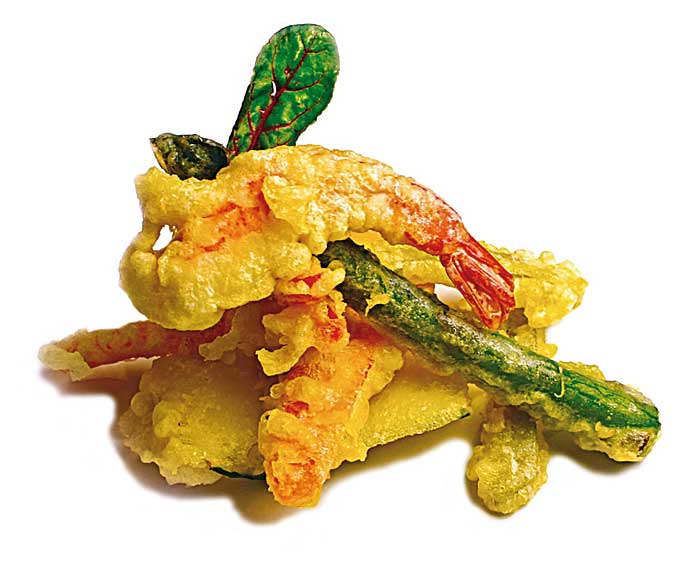 Prawn tempura
Prawn tempura
4 prawns
1 bag (1/2 kilo) tempura flour
1 bottle Ten-Tsuyu sauce
1 courgette
1 carrot
6 sprigs parsley
6 wild asparagus
6 snap peas ("tirabeques")
This dish has a curious history. Today it is an icon of Japanese cuisine, but its origin is Spanish, from the famous Andalusian fried snacks taken to that country by the Franciscan Fray Pedro Bautista -now St. Pedro Bautista- in 1593, on the occasion of his peacekeeping mission to the powerful and irate Shogun Hideyoshi Toyotomi, orTaykosama, as he is called in Spanish History books.
It is named tempura after the "témporas" fasts performed by these monks in their monasteries in Kyoto, Nagasaki and Osaka. The Japanese, who were, according to St. Pedro Bautista himself, "moderate people in eating and drinking", liked that delicate way of preparing fish, seafood and vegetables, and adopted it, but trying to find the most ethereal way possible.
Therefore, it must be cooked with rice, corn or wheat pastry flour, or right with tempura flour, which is mixed with lyophilized egg. That is the easiest way, but if there is some celiac person among the guests you will have to resort to corn or rice flour.
One important trick is to use icy water for the batter so it gets very smooth.
It is going to be eaten with chopsticks, so all the pieces must be bite-sized excepting the prawn, which can be left uncut with the tail unpeeled so that it can be taken to the mouth with the fingers.
Some cooks dip the ingredients in a mixture of sake and salt before battering them. Sesame oil should be used, but the most important thing is that the oil must be very hot, that way the fried pieces will not be greasy and the crispy crust will be very thin, almost imperceptible, unlike those "armour-plating" things we are usually fed with at Spanish receptions.
A bowl with
Ten-Tsuyu sauce must always accompany this dish. This sauce is a blend of broth, soya sauce, sweet sake, grated ginger, radish and spices. It is better to buy it readymade.
.jpg) Red tuna sushi
Red tuna sushi
600 grs. red tuna in a clean block
1 large cup round grain rice
Nori seaweed
Soya sauce or Tamari (gluten-free)
Wasabi
Many people think that sushi is a dish of raw fish, but it is dish of moulded rice which can be enriched with many things, of course there may be raw fish in it but also other ingredients such as Japanese omelette, grilled meat, vegetables, roe…
The tricky part is then how to cook the rice. The most important thing is that it must be round grain. It must be washed to eliminate the starch and left aside for half an hour, until its outer layer gets moisturized.
Put the rice in a saucepan with the same volume of water (better 1/1.2) and a pinch of salt and bring to the boil. Boil it for five minutes, lower the heat and wait until you can see small holes on it, showing that the water has been absorbed.
Leave to stand for five minutes and turn it out onto a clean surface. It is customary to use a fan to eliminate steam. Sprinkle with Sushi Su (sake vinegar seasoned for sushi), stir and leave to stand for some minutes, until it absorbs the seasoning.
If you are going to make makisushi, use a mat to wrap the rice with nori seaweed, but if you want to make a niguirizushi like the one in the picture, the most orthodox one, you must have a large bowl with warm water to wet your hands before making each ball. They must be bite-size, no more than three or four centimetres long.
Once the rice bites have been prepared, cut the tuna into slices the same size (a bit longer actually, so that they cover the ends) and put them on the balls. It is customary to put some wasabi (green radish paste, often mistaken for mustard) between the rice and the tuna slices.
Thin strips of nori seaweed can be used to fold up each “parcel”, but it is just for ornamentation.
They must be eaten dipped in soya sauce (tamari for celiacs), which can be made hotter with some wasabi.
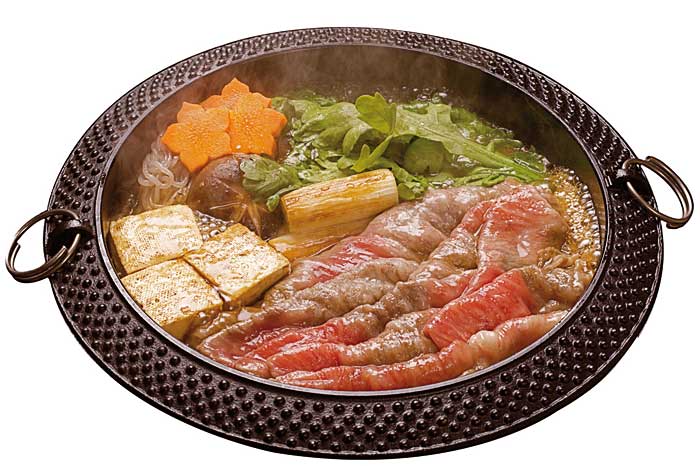 Sukiyaki
Sukiyaki
½ kg. beef tenderloin
¼ kg. beef fat
2 pieces tofu
1 bundle rice noodles
50 grs. frozen spinach
200 grs. fresh green beans
1 onion
8 sihitake mushrooms
1 turnip
2 carrots
2 leeks
4 eggs
1 large cup soya sauce
1 large cup mirin
Long before Japanese cuisine boomed in our society, I mean in the sixties, a singer called Kyu Sakamoto got a hit with a ballad entitled “Ue o muite aruko”. Since nobody knew what it meant, a British producer called Louis Benjamin released it with his record label Pye Records as “Sukiyaki”. We did not know what it meant, either, but it was such a success that this vegetables and beef stew became a famous dish worldwide.
Traditionally, it was a festive dish which used to be cooked on a bonfire in the open country and the whole family ate from it, but since it became famous restaurants have developed sophisticated techniques to cook it on the table in customers’ view.
Put a large “rechaud” or a small camping gas cooker on the table –they are sold “ad hoc” for fondues- and heat well a Sukiyaki cast-iron dish (they can be found in many home accessories shops).
When it gets hot, rub it with the beef fat until it gets scorched (some smoke will be produced). The ingredients must be put on the dish following this order: meat, leek, onion, carrot and green beans. Cook them trying not to mix the different products.
When they get roasted, pour the sauces on them. More smoke will appear, but with a characteristic, very pleasant smell of Japanese cooking from all the ingredients.
Add the rest of the ingredients, trying to achieve an aesthetic appearance by distributing green spinach, white tofu, brown mushrooms… Add the grated turnip and the noodles -these must be dipped so that they get well cooked.
Cook for ten minutes. Meanwhile, beat one egg in each bowl using the chopsticks. When the dish is ready, the diners will help themselves to the Sukiyaki. The dish must be on the heat until the food is over.
 Sweet and sour pork
Sweet and sour pork
1 kg. lean pork
1 beer
Flour (it can be wheat, corn, rice or chickpeas)
1 onion
1 green pepper
1 red pepper
50 grs. butter
1 fresh ginger bulb
1 orange
1 small glass sake or cider vinegar
2 spoonfuls molasses or honey
This is said to be a very ancient Cantonese recipe, in particular from the region of Jiangsu, north of Shanghai, but the presence of peppers in it –of American origin- makes me doubt.
Logically, it has undergone a thousand changes over the centuries, to the extent that nowadays, in cheap Chinese restaurants, it is prepared with some industrial sauce made of water, sugar and monosodium glutamate (MSG).
Our recipe is delicious, but it takes some time.
Chop the ginger, take some strips of orange peel (without the white part) and caramelize both things together in butter with brown sugar. Cook it on a low heat with the pan covered. When it gets tanned, add the vinegar, bring it to boil and add the orange juice and the molasses. Cook it slowly until it gets syrup-like. Then, blend it in a mixer and pass it through a sieve to eliminate the small threads from the ginger.
Now let’s prepare the pork. Make the batter by putting the flour and the beer in a bowl. Stir adding flour or liquid until you get a creamy, sticky dough, not liquid.
Cut the pork in chunks the size of a domino, season with salt and pepper, put it in the bowl with the dough and stir well.
Heat soya oil in a deep frying pan and put the meat balls in it, placing them so that they do not touch one another. Don’t heat the oil too much or the batter will get burnt. Take the pieces out of the pan when they get a golden colour, using a slotted spoon, and put them on a colander with absorbing kitchen paper.
Now we are going to prepare the vegetables. Many recipes include carrot, but I do not use it because it is a foreign product that only reached China in the 20th century.
Chop the onion and peppers in pieces the size of a coin. Put them in the wok with a dash of soya oil. A couple of stirs will be enough to make them smooth but crispy. Pour the sauce on it, stir and add the fried pork.
A jug with soya sauce and a bowl with spicy Chinese sauce must be placed on the table so that each diner can season the dish to taste.
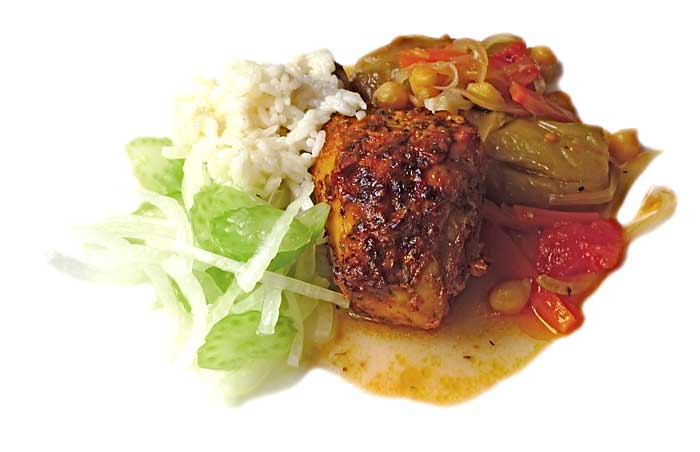 Tandoori Chicken
Tandoori Chicken
3 chicken leg quarters
2 yogurts
5 garlic cloves
2 spoonfuls paprika
2 spoonfuls turmeric
3 spoonfuls cumin powder
1 teaspoon oregano
1 spoonful thyme
1 spoonful cardamom
1 spoonful black pepper
1 spoonful red pepper
1 spoonful ginger powder
1 lemon
Extra virgin olive oil, salt
“Tandoor” or “Tandoori” is the name given to a clay oven where many Indian dishes are cooked, but these are also designed by that name, so this dish should be properly called “chicken roasted in a wood-fired oven”. However, the result is not what one would expect by that description –you only have to read the ingredients to imagine.
There are prepared blends with the name “Tandoori”, but that word is wrong, the right one would be “Garam masala”, which actually means nothing, just “spice blend”, so there are thousands, perhaps millions, different combinations.
You may be surprised to see paprika among the ingredients. In fact, it should be Kashmiri red chilli, which is sold dry or powdered. This spice is responsible not only for the hotness of the dish but also for the colour: the more turmeric the more yellow, the more Kashmiri the redder.
This is the recipe.
Ask your butcher to peel the chicken and to cut each leg quarter into three pieces so that the meat is more thoroughly seasoned.
Marinate the meat the day before. In a large bowl, mix the yogurt, lemon juice, thinly chopped garlic and all the other spices. Stir well until smooth and add the chicken. It must be totally covered with the blend, so you may move it from time to time while marinating, because the chicken drains water.
If you are patient enough you can roast it as Hindus do: Preheat the oven well and put the chicken in it, on an earthenware dish. When it starts getting roasted, take it out, turn it upside down and put it back in the oven. When the other side starts roasting, take it out and set aside. Repeat this operation three or four more times, alternatively heating and cooling the meat, so that it gets cooked little by little, getting crispy outside and juicy inside.
This dish is traditionally served with onion salad and basmati rice as side dishes.
 Turkey curry
Turkey curry
1 kg. turkey breasts
2 limes
1 onion
3 garlic cloves
1 chilli pepper
Fresh ginger
1 plain yogurt
1 bunch fresh coriander
2 spoonfuls tomato sauce
Cashew nuts
Raisins
Laurel
Vegetable broth
For the curry
1 spoonful cumin
1 cinnamon stick
12 cardamom berries
1 spoonful coriander seeds
1 spoonful black pepper grains
1 spoonful turmeric
½ spoonful hot paprika
The word “curry” can refer to different things: the spice itself, a blend of spices, the sauces made with that blend and an endless number of dishes cooked with those sauces.
In India there are a thousand curries, from the mild ones from places near the Himalayas, such as Kashmir, to the very hot ones from the south -Andrha Pradesh, Kerala, Tamil Nadu..., what used to be generically called Madras (now officially known as Chennai). These are the best known ones, the famous Madras curries, among which there is also a great variety.
Actually, curry means “sauce” in Tamil language ("kari", which the British transformed into “curry” according to their extravagant spelling), so it is like saying sauce when speaking about French cuisine, that is, nothing.
This homemade curry could be considered a Madras curry, but with less chilli pepper than it is customary there.
Firstly, chop the turkey breasts into pieces the size of a quail egg. Marinate them in the juice from the limes. We have chosen turkey, but it may also be made with chicken or lamb, in fact it would probably be juicier with lamb.
While the meat is marinating, prepare the spice blend by grinding together all the spices listed under “for the curry” in a large mortar.
Finely chop the onion and the garlic, and cook in a frying pan with some light oil (soya, corn or refined olive). When it starts to brown, add sliced chilli pepper, chopped ginger, tomato sauce and the meat, and sauté it. Add the curry blend, stir and add broth until it gets a creamy texture. Set aside.
Put the yogurt in a bowl, together with the bunch of fresh coriander thinly chopped. Stir until it is well mixed.
Be careful now. From this moment on, the sauce must not boil. Turn down the heat.
Add the yogurt mixture, the cashew nuts, the raisins and a laurel leaf.
Leave to stand overnight. The ingredients will get oxidized, modifying their tastes and achieving a much more harmonic and pleasant mixture.
When you heat it again, remember that the sauce must not boil, so use a covered pan on a low heat.
It must be served with Basmati rice as a side dish and a sauce made with yogurt, cucumber and fresh spearmint.
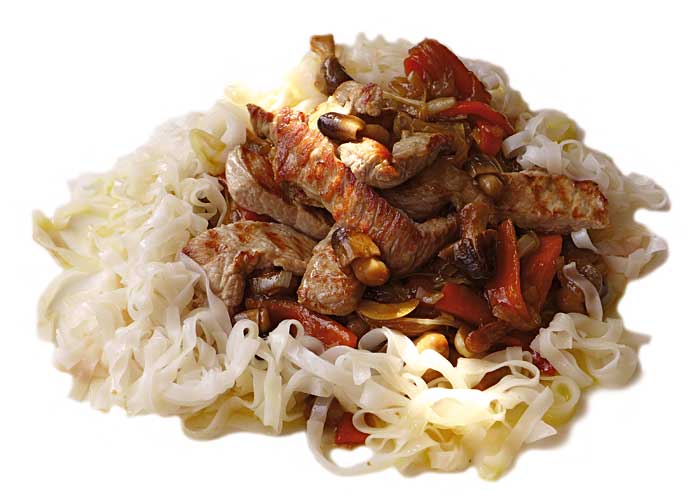 Veal in oyter sauce
Veal in oyter sauce
½ litre chicken broth
½ kilo veal lean meat
1 carrot
1 onion
1 leek
50 grs. fried cashew nuts
1 can bamboo shots
1 tray Shiitake mushrooms
1 ball ginger
2 garlic cloves
Oyster sauce
Oyster sauce was accidentally discovered by an oyster farmer called Lee Kam Sheung in the Cantonese city of Zhuhai. The invention was so successful that in a few years his company, Lee Kum Kee, was selling it all around the world.
Obviously, the sauce that can be purchased nowadays has little to do with the original, but its taste is so penetrating that you will instantly perceive the flavour of China in your mouth.
It is a simple recipe, as it is very close to our sautés.
Put chopped onion, crushed garlic, grated ginger and strips of pepper in a wok. Cook it on a strong heat so that it does not get caramelized but it gets golden, keeping part of its original texture.
Add chopped mushrooms, fresh soya shots and cashew nuts, cook for a while and add the broth with a dash of soya sauce and a spoonful oyster sauce. Be careful with that sauce as it is very salted and could spoil the dish.
Allow it to evaporate until it gets a creamy texture and add the veal, cut into thin slices the size of a date.
Serve quickly, before the meat gets hard –the meat will get cooked with the residual heat if it is cut into very thin slices. Sprinkle some toasted sesame grains and –budget permitting- four oysters for one minute, just to let them set and blend their water with the sauce to enhance the flavour. When serving, place one oyster on top of each dish to finish it.
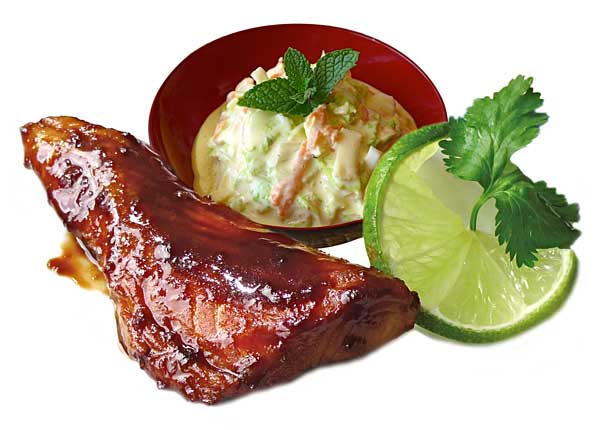 Yaki Sake
Yaki Sake
800 grs. salmon in two thick slices
1 glass sake
1 cup mirin
1 small cup soya sauce
1 cucumber
In Japan, there is a very popular way of preparing fish called Shioyaki, consisting in salting, seasoning or macerating fish and then roasting it on a grill, so that it gets a beautiful golden colour and a lacquered look, in addition to a delicious taste.
Yaki Sake is prepared with salmon, one of the most valued fish in Japanese cuisine.
Clean the salmon slices, separating the two halves and removing spines and bones. You can leave the skin, as it gets crispy and delicious when roasted, as long as the scales are carefully washed off. If not, remove the skin. The salmon may be washed.
Mix all the ingredients of the seasoning in a soup bowl –Teriyaki sauce can be found readymade in Spain, but that is how you can make it at home. Dip the salmon in it, trying to cover it completely. Marinate for a couple hours, turning it over from time to time.
Cut off the ends of the cucumber and cut it into very thin slices using a mandolin slicer. Mix with coarse salt and let sweat. When the grill is ready, wash the slices and dry them completely with a kitchen towel. Season slightly with sake vinegar.
Put the salmon on the grill (or on a frying pan), on a strong heat. If the skin has been left, roast that side first until it gets crispy. Once one side gets golden, lower the heat, turn it over and cover it with cucumber slices, which will make that side juicier. That part is optional; you may simply serve the cucumber as a side dish with the salmon.
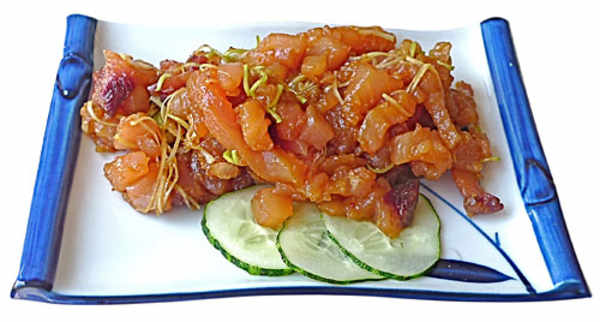
![]() Pueden ver la versión española pinchando en Recetas asiáticas
Pueden ver la versión española pinchando en Recetas asiáticas
 Assorted sashimi
Assorted sashimi
 Chicken Yakitori
Chicken Yakitori
 Dim sum
Dim sum
 Fried rice with shrimps
Fried rice with shrimps
 Hamachi Kama
Hamachi Kama
 Japanese salmon tartar
Japanese salmon tartar
.jpg) Lacquered prawns
Lacquered prawns
.jpg) Orange duck wings
Orange duck wings
 Pad Thai
Pad Thai
.jpg) Peking lacquered duck
Peking lacquered duck
 Prawn tempura
Prawn tempura
.jpg) Red tuna sushi
Red tuna sushi
 Sukiyaki
Sukiyaki
 Sweet and sour pork
Sweet and sour pork
 Tandoori Chicken
Tandoori Chicken
 Turkey curry
Turkey curry
 Veal in oyter sauce
Veal in oyter sauce
 Yaki Sake
Yaki Sake












